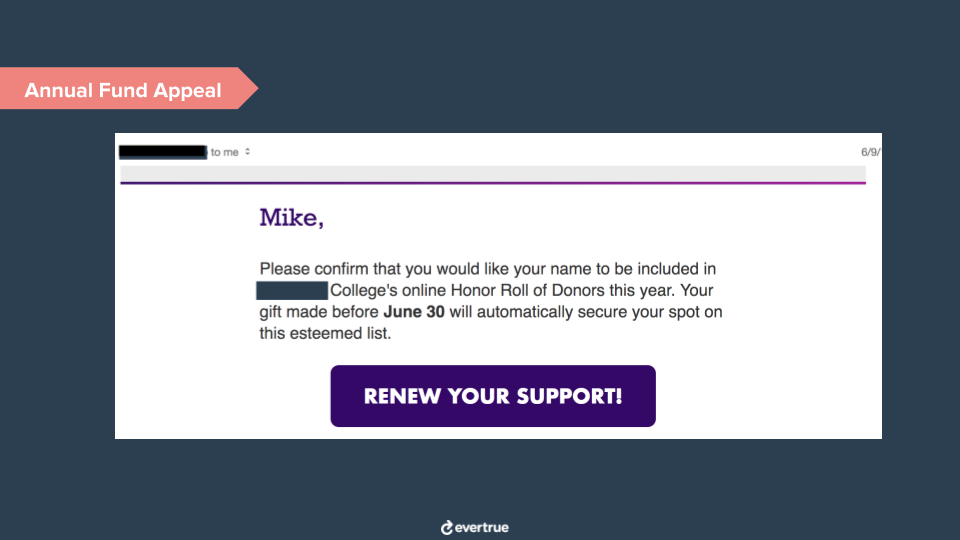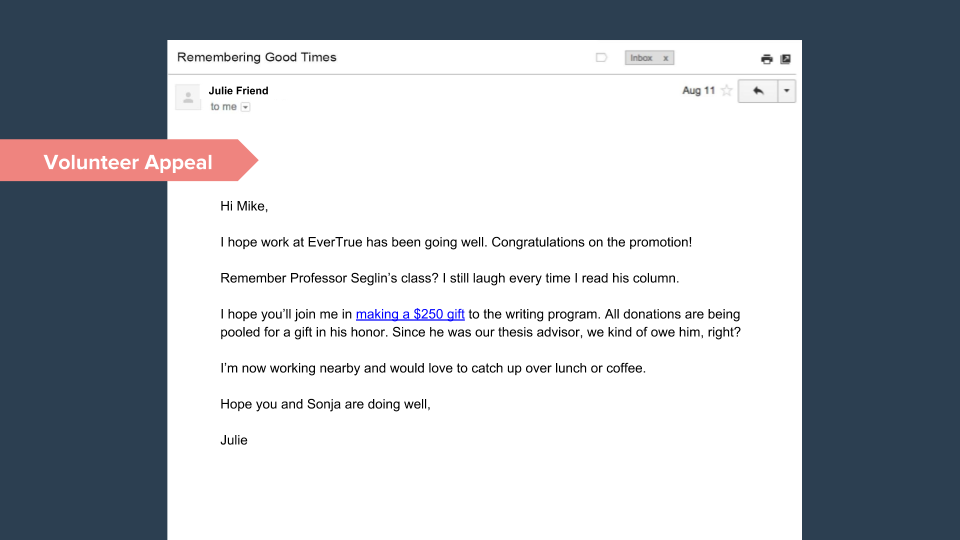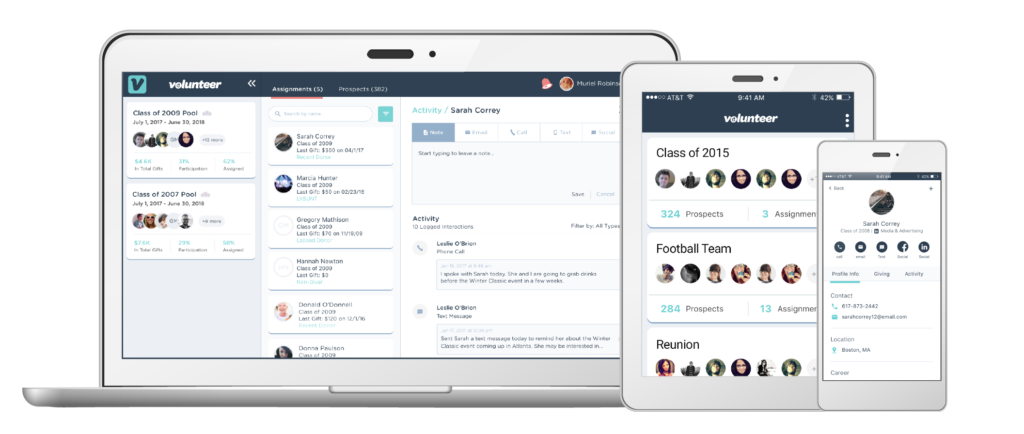Let’s look at a pair of appeals and you tell me which one you’d rather receive.
Here’s the first. This is an actual email I received in early June (I won’t say who it was from).

Honestly, the chance to be listed on an “honor roll” was pretty underwhelming. The message felt generic and non-specific. It wasn’t at all personalized to me or my interests.
While I did “renew my support” that year, I would have contributed more if I had known how my gift would have been used, if the ask was connected to something I care about, or if it came from someone I knew.
Something more like this….

Peer-to-peer Fundraising is Powerful
Institutions who have volunteer fundraisers are 5x’s more likely to have a participation rate that’s above 20% (which is nearly double the current industry average).
There’s also a correlation between the number of volunteers and the institution’s participation rate. The more volunteers an annual fund team uses, the higher its participation numbers.
92% of people trust the recommendation of a friend over marketing, meaning potential donors are more likely to respond to outreach from someone they know.
(For more info, read the survey results in the state of volunteer fundraising.)
Recently, I had the chance to sit down with Laura Day, Director of Annual Giving at Williams College, and Deb Vanecek, Director of the Annual Fund at Millbrook School, for a conversation on how they’re running volunteer programs that drive results.
The proof is in the end-of-year stats. Williams College’s 1,600 alumni volunteers carry the institution to a leading annual participation rate of 54.52% while expanding Millbrook’s volunteer program has led the school from a 28% participation rate six years ago to 43% in FY18.
Watch our conversation on volunteer fundraising programs in its entirety or keep reading for key takeaways.
Volunteer Programs Change Annual Fund Job Descriptions
If your annual fund transitions to a volunteer-driven program, staff responsibilities have to shift, too. The focus changes from being a direct fundraiser or leadership gift officer to a team manager whose goal is to empower others to do the work.
“When we’re out on the road, we’re primarily meeting with volunteers,” says Laura. “It’s either cultivation of prospective volunteers or stewardship of existing volunteers. It’s really a coaching-type relationship that we maintain with our volunteers.”
With more than 200 volunteer fundraisers at Millbrook School, Deb’s mission is to try and meet with every one this year, whether it’s at the school’s volunteer leadership summit or on the road.
“I think our class agents are far more effective and productive with the great tools that are available to them so we can then spend time creating programs around our class agents that are more robust and more meaningful,” Deb says.
While it’s important to connect with volunteers directly, it’s also critical to be on the same page internally, especially when volunteers are making leadership and major gift-level asks.
“There’s always a little learning curve for new gift officers about how comfortable we are working with volunteers at Williams,” says Laura. “So when we have new folks who ask, ‘Wait, you’re going to have a volunteer ask my prospect for $10,000?’ We say, ‘Yes. That’s who they have the relationship with. You’re new and they’ve been giving at significant levels, so we can work with the volunteer to ask them to renew or move them up to a $25,000 gift this year.’”
A great volunteer program manager has to communicate well, set clear expectations, and work collaboratively to be successful.
Help Volunteers Run Sprints, Not Marathons
Just because the annual fund runs 24/7 for an entire year doesn’t mean your volunteers can (or want) to do the same.
Both Williams and Millbrook have their volunteers work on tasks for short periods of time to keep them engaged and effective.
At Williams, the volunteer fundraising year runs from October 15 to March 15 (they raise 94% of their dollars and acquire 96% of their donors during this time). Millbrook relies heavily on volunteer outreach at key points (calendar and fiscal year-end) along with a month-long participation challenge every February.
“The Headmaster’s Challenge is where our class agents are the most active and engaged and they full-on text all day, everyday for all of February. And I think I have curvature of the spine because of it, because in the month of February, that’s all I do,” Deb said. “I spend my time sending text message samples, letting each of the class know exactly where they are in terms of participation. And we’ve seen enormous growth in participation and donors changing their giving behaviors for the month of February for this program. Volunteer by EverTrue has been hugely helpful in getting them the data that our volunteers need, and it frees me up to tell them exactly what’s left to go after.”
At Williams, Laura and her team run volunteer-driven campaigns at different times of the year — a giving challenge against Amherst in the fall, a “buy a book for a student” initiative in January at the start of the term, and February outreach to give volunteers air cover in advance of the self-imposed March 15 deadline.
Care About Participation? You Care About Young Alumni
At most institutions, the most recent classes are the largest. Therefore, they’re the biggest influencers of participation rates. Reaching these classes has to start before they leave campus.
Williams runs a program where the head of the alumni association asks fellow graduates to write notes to incoming and returning students who share the same on-campus mailbox. This year, they received 1,700 letters from graduates — nearly one for every new student. This kind of one-to-one outreach helps build connections that span generations.
They also try to have 100 percent of the graduating class assigned to a classmate solicitor, which means class agent recruitment starts early. By the end of junior year, Williams has recruited 25-30 agents for its graduating class and is educating them on the importance of volunteer support.
“We take them out for coffee and talk about not just what they’d be able to contribute as a volunteer, but also the highly transferable skills that they’ll build through their volunteer work that can help them advance their careers,” says Laura.
During the Headmaster’s Challenge at Millbrook School, the advancement team works with facilities to light up areas of campus that are powered by donor support.
“We light up sections of the campus in Millbrook blue with spotlights as we hit different milestones,” says Deb. “So in essence, the whole campus becomes aware of the annual fund and the Headmaster’s Challenge. It’s just a super-easy way to get all of our students aware of annual fund, the importance of it, how it’s helping them.”
Teach students why giving back matters before they leave campus and the annual fund will be more successful after they do.
Put Volunteers Front-and-Center
Both schools talked about the importance of using volunteers to be the voice of the institution — whether it’s as part of annual fund appeals or to help motivate and organize other volunteers.
It goes back to the point I brought up earlier in this post. People want to hear from a peer, not a marketer!
In regular newsletters to its volunteers, Williams includes examples of successful volunteer outreach to help guide other peer-to-peer fundraisers.
“We include appeal screenshots that volunteers send in to share with other volunteer fundraisers or their answers to frequently asked questions,” says Laura. “We even share texts that we’ve practiced with each other here at the office just so that our volunteers get more comfortable using texting to ask… The more samples, the better!”
Both organizations use “head agents” to coordinate class-based efforts and provide another layer of oversight into volunteer activity. It takes trust in your volunteer fundraisers to run an annual fund like that — they may not always do things the way you would — but these peer-driven programs are successful because they’re authentic.
Volunteers Need the Best Technology to Do Their Best Work
Building a great volunteer program means recruiting and training great volunteers, but they also need the right tools to do their job.
They should be able to easily access assignments, check off to-do lists, review progress toward dollar and participation goals, and reach out to fellow grads from anywhere — whether it’s at night after work or from their phone during a lunch break.

“I don’t know any other company out there that works the way EverTrue does,” says Deb. “The technology is easy to use. The platform is clean and dynamic. Our volunteers love having access to their classmates and assignments right from their phones.”
Volunteer management software is critical to unlocking the full potential of any peer-to-peer fundraising program. Many schools use spreadsheets to coordinate volunteer assignments and track giving, but they’re a huge pain to assemble and immediately out-of-date as soon as they’re produced.
The right technology eliminates that internal administrative work, freeing advancement staff to work strategically while also putting current donor information in the hands of every volunteer.
Watch the Conversation
I highly recommend you take the time to watch the conversation with Williams College and Millbrook School. Laura and Deb share a wealth of information on how they’ve organized and run their respective programs and there are far too many takeaways to share in just one blog post.
If you’re interested in learning more about how Volunteer by EverTrue can take your peer-to-peer fundraising program to the next level, watch this video to see it in action.